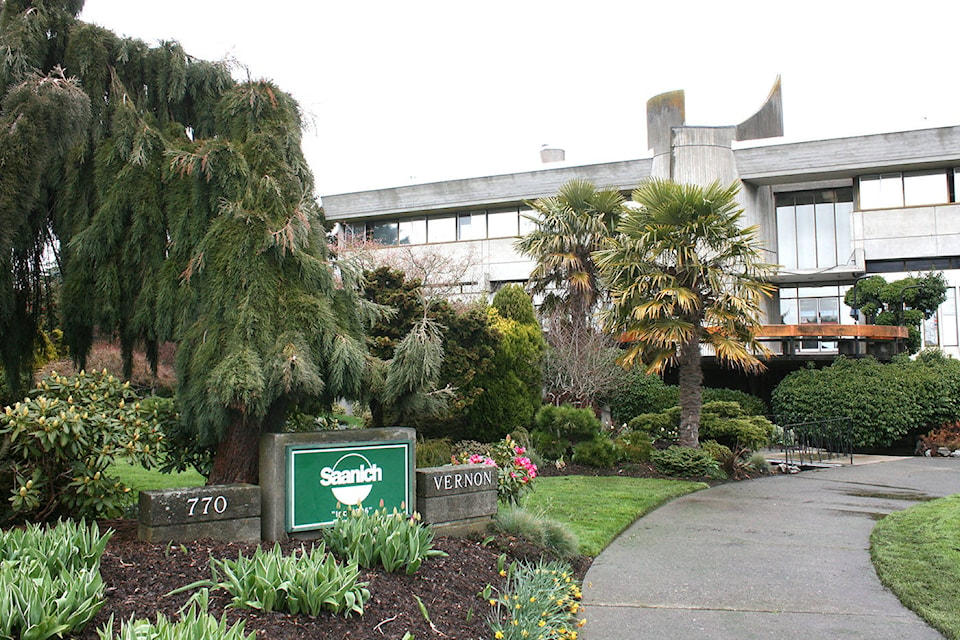Saanich is moving ahead with plans to de-carbonize the community, but questions about its costs and execution remain.
Council Monday approved terms of references for a plan that commits the community towards using 100 per cent renewable forms of energy by 2050, cutting greenhouse gases (GHGs) responsible for climate change by 80 per cent along the way.
Council approved the terms of references 7-1, with Mayor Richard Atwell opposed.
By approving the terms of references, Saanich starts to shape an earlier direction from council approved in March. Specifically, it updates Saanich’s existing policy.
Coun. Dean Murdock praised the approach.
“I see this as something that allows us to be ambitious, to move forward with a particular vision in mind, and then assemble the pieces in order to achieve it,” he said.
He also prepared the public by predicting that the plan could challenge the district and the community at-large.
“Ten years ago, we were one of the leading communities in the province in addressing this, and taking a leadership position on climate change,” he said.
“I don’t know that we could hold ourselves up as being in that leadership position anymore. But I definitely think that the completion of this plan and moving forward towards implementation would put us in good stead to renew our place at that leadership table.”
Saanich was the first municipality to introduce a carbon fund to help pay for low-carbon projects. The District of Saanich also reduced its own GHGs faster than its initial planning. Recent years, however, have witnessed a reversal of this trend. Saanich’s GHGs have actually risen in recent years.
Rebecca Newlove, manager of sustainability, acknowledged these developments, but pointed to various projects that would help Saanich meet its goals for 2020.
Coun. Susan Brice urged Saanich to pay attention to the concerns of community members. Day-to-day economic calculations made around the family kitchen table will ultimately decide whether Saanich will be able to cut down its community greenhouse gas emissions, she said. “It is going to be important that we as a community share what the actual data is, give suggestions where families can make investment, and over time that will help us achieve those community targets,” she said.
Council’s decision came during one of its last meetings as a council of eight following the death of Vic Derman, a vocal champion of measures designed to mitigate climate change.
“This is a step that he would have supported and would have been very proud to have been involved with,” said Colin Plant.
But for all of its symbolism, the meeting also confirmed that much work remains ahead.
Newlove told council that 100 per cent renewable means that all of Saanich’s energy sources would be renewable by 2050. “One hundred per cent renewable energy means there is no fossil fuel in there,” she said.
This statement raised a number of questions. For example, what would power the house of the future in 2050? “That’s a key component of the plan,” said Newlove. “What are the opportunities moving forward? What steps do we need to take in the next 10 years to answer that very question?”
While some of the answers are already available, others will emerge, she said. “So I don’t have all the answers at this stage, and that really is the purpose of the plan. Those are the questions that will be asked, and hopefully, to some degree answered.”
Atwell, however, sounded reserved. “Largely at this stage though, it is an unknown,” he said. “We don’t know where that source of energy is going to come from.”
“We have some clear indications of the next steps for renewables,” said Newlove, pointing to various plans that would help Saanich reduce energy consumption as a starting point to larger changes.
Atwell agreed with the general thrust of the plan, but questioned the request for $100,000 towards its implementation.
“The only issue I have with this is the funding,” he said. Saanich, he said, should look for funding from other sources rather than tap into its strategic reserves. Saanich should first look for outside funding, he said.
While Saanich will look for outside funding, Atwell fears that funding agencies will reject Saanich if they know that Saanich has already put money towards the plan.
“We need to challenge ourselves more to go out to get this funding,” he said. “To rely on taxpayers like this, is an ongoing difficulty.”



